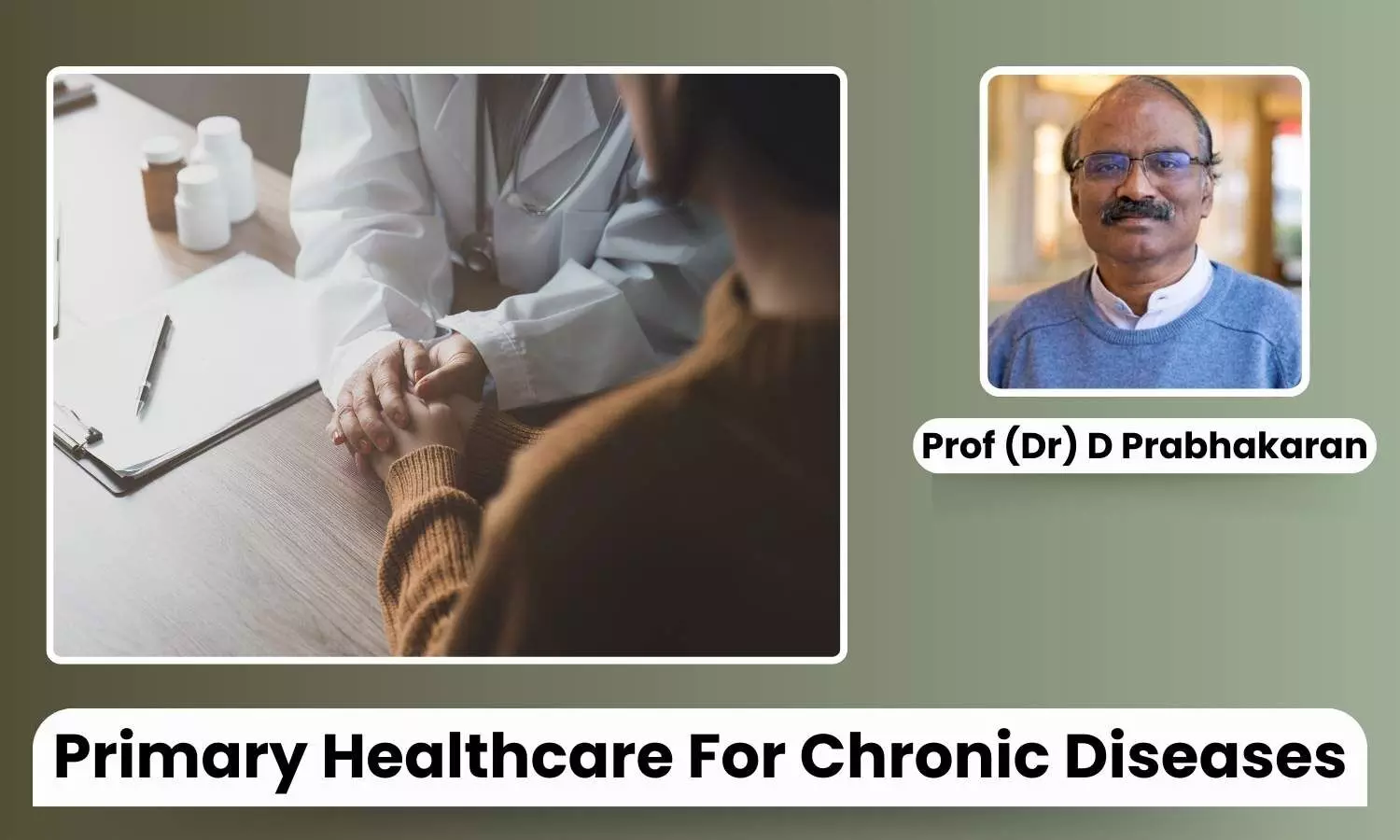Innovations to Redefine Primary Healthcare to Address Chronic Diseases - Prof (Dr) D Prabhakaran

The common misconception is that all chronic diseases require high-end specialist care. Majority of chronic diseases and their risk factors can be managed by a primary care physician.
It is quite likely that many of these were patients who were unable to access healthcare facilities, because of the exorbitant cost. Many evidence based treatments available for example for hypertension, diabetes and cardiovascular diseases are simple, inexpensive and widely available. Despite this scenario, the awareness, treatment and control rates are poor.
Primary Healthcare plays a critical role in the detection and management of chronic diseases such as cardiovascular diseases (CVD), stroke and diabetes to reduce morbidity, disability, and premature mortality.
In India and other developing nations, the prevalence of chronic diseases is on the rise, and inadequate resources and infrastructure make it challenging to manage them effectively.
Without any doubt, there is an urgent need for a robust primary healthcare infrastructure that is affordable, accessible and sustainable. Beyond human resources, we need simple, frugal technologies that provide easily accessible health benefits at a lower cost.
A few examples of these frugal out-of-the-box technologies that are being used by the healthcare fraternity, to bring relief to patients, are listed below:
Telemedicine
Online Doctor Consultations: Long commutes to clinics and overcrowded, overburdened facilities often result in long waits and delays in receiving care. Telemedicine, a relatively recent healthcare service, provides patients with healthcare at their fingertips. This innovation has bridged the gap between doctors and unwell individuals, through video consultations.
Mobile Health Apps: Today, we have mobile apps for diabetes management and CVD to provide education, medication reminders, calorie counting, workout monitoring and remote consultations with doctors, reducing clinic visits and costs.
Cloud-Based ECG: Affordable, portable ECG devices connected to smartphones, allow healthcare workers in remote areas to send readings to specialists for prompt diagnosis of heart issues, saving time, money and lives. As the adage goes, time is muscle in the face of a heart attack.
Technology-Aided Diagnosis & Monitoring
AI-Powered Fundus Cameras: Low-cost, portable cameras with AI algorithms allow eye care workers to detect diabetic retinopathy early, preventing vision loss.
Bioimpedance Devices: Affordable devices measure body composition and fluid shifts, aiding in early detection of heart failure and preventing complications.
Point-of-Care Testing
Blood Glucose Monitors: Inexpensive and readily available, these empower patients to self-monitor their diabetes, improve blood-glucose control and reduce complications.
Urine Test Strips for Albumin: These are simple and affordable tools for detecting early signs of kidney damage in diabetics and CVD patients, allowing for timely intervention.
Inexpensive AI-Enabled Monitoring Mechanisms
Artificial intelligence (AI) is transforming healthcare by providing innovative solutions for the diagnosis and treatment of chronic diseases. AI-enabled monitoring mechanisms can be used to monitor patients with chronic diseases and provide real-time data to healthcare providers.
This data can be used to identify patients who need immediate medical attention and provide them with timely care. AI can also help in reducing the burden on healthcare systems by providing remote monitoring and care to patients with chronic diseases.
Portable Radiography
Portable radiography devices can be used to diagnose and monitor patients with chronic diseases. These devices are inexpensive and can be used in primary care settings.
Portable radiography can help in reducing the burden on healthcare systems by providing remote monitoring and care to patients with chronic diseases.
Community-Based Interventions
Community engagement is being increasingly recognized as one of the important strategies to improve the health of people. Communities, when meaningfully engaged, can provide valuable insights into what works for whom and under what circumstances.
Views of individuals with lived experience of chronic conditions as well as the communities they live in can inform the design and implementation of context-specific programs and services for chronic conditions.
Multiple studies have shown that team-based care, employing task-shifting and task-sharing principles, significantly helps provide optimal and evidence-based care to patients with chronic diseases.
Several tasks need to be completed in patient care to ensure continuity and coordinated care, and not all of them can be achieved by a solo provider. These tasks include counselling for lifestyle modification, self-management support, and protocol-based regulation of medicines.
ASHA (Accredited Social Health Activist) workers have been successful in delivering multiple interventions at the community level. However, most ASHA workers experience a high work burden due to various responsibilities, population coverage, and extended work hours.
With adequate capacity building and support from community health workers and multiple members of primary care, it is possible to deliver patient-centered care to achieve desired outcomes.
Mobile Medical Units
Bicycle Ambulances: In remote areas, trained paramedics on bicycles reach patients quickly for emergency CVD and stroke care, improving survival rates.
Medical Vans: These vans are equipped with basic diagnostic tools and emergency care equipment and enable healthcare professionals to visit remote villages, providing access to screening, basic treatment, and referrals for CVD and diabetes. In addition, they can be great enablers of telemedicine.
Biotechnology
Biotechnology has transformed healthcare by providing innovative solutions for the diagnosis and treatment of chronic diseases.
Inexpensive diagnostic tests and treatments have been developed using biotechnology, which can be used in primary care settings. It is also used to develop personalized treatments for patients with chronic diseases, thereby improving their outcomes.
Internet of Medical Things (IoMT)
The Internet of Medical Things (IoMT) allows connected devices and sensors to monitor patients with chronic diseases 24/7, remotely, and provides real-time data to healthcare providers.
These data are then used to identify patients who need immediate medical attention. Assisting hospitals in enhancing their operations through increased automation, predictability, and cost-effectiveness, IoMT solutions integrating biometrics and predictive maintenance liberate nurses from equipment management and diagnostic interpretation responsibilities. As a result, nurses are empowered to do what they are meant to do - dedicate time to personalized patient care.
In India, where the healthcare industry ranks among the largest globally, frugal innovations have empowered healthcare providers to deliver cost-effective medical goods and services. We have been able to foster self-reliant healthcare facilities which address multiple needs of patients.
These easy-to-implement, frugal technologies have helped improve the outcomes of patients with chronic diseases and reduce the burden on healthcare systems. It is essential to invest in these technologies and promote their adoption to ensure that everyone has access to affordable and quality healthcare.
Disclaimer: The views expressed in this article are of the author and not of Health Dialogues. The Editorial/Content team of Health Dialogues has not contributed to the writing/editing/packaging of this article.


